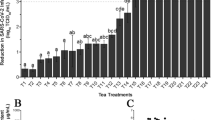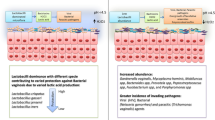Abstract
Objectives
This study determined the quantity of periodontopathic bacteria in saliva, subgingival plaque, and placenta on the threatened preterm labor (TPL) and preterm low birth weight (PLBW) subjects in order to identify specific periodontal pathogens with high association to adverse pregnancy outcomes.
Methods
We used real-time PCR with TaqMan probe and ELISA to detect the amount of Aggregatibacter actinomycetemcomitans, Porphyromonas gingivalis, Tannerella forsythia, Treponema denticola, Fusobacterium nucleatum, and Prevotella intermedia in subgingival plaque, saliva, and placenta tissue, in addition to serum IgG titers against these bacteria in 28 patients with TPL and 36 healthy pregnant women.
Results
Thirteen of 64 births delivered PLBW infants. All 6 periodontopathic bacteria were detected in the placenta samples. The amount of F. nucleatum and detection frequency of T. denticola in placental samples was significantly higher in the TPL group than in the healthy group. Meanwhile, the age, anti-P. gingival IgG in serum, amount of P. gingivalis and T. forsythia in plaque samples, detection frequency of P. intermedia in saliva, and percentage of pocket probing depth ≥ 5 mm were higher in TPL-PLBW births than those in TPL-Healthy delivery (HD) group and/or in H-HD group. Ordinal logistic regression analysis revealed that the presence of F. nucleatum in placental tissues was significantly associated with TPL, while the maternal age was significantly associated with PLBW in TPL.
Conclusion
Our findings suggested all 6 bacteria may access the placenta. The increased presence of F. nucleatum in placenta might be related to TPL, while advanced maternal age might be associated with PLBW in TPL.
Clinical relevance
Periodontal therapy should be applied to reduce the deep periodontal pocket sites and the colonization of periodontal pathogens in high-risk population.


Similar content being viewed by others
References
Pihlstrom BL, Michalowicz BS, Johnson NW (2005) Periodontal diseases. Lancet 366(9499):1809–1820
Hajishengallis G, Lamont RJ (2012) Beyond the red complex and into more complexity: the polymicrobial synergy and dysbiosis (PSD) model of periodontal disease etiology. Mol Oral Microbiol 27(6):409–419
Lamont RJ, Hajishengallis G (2015) Polymicrobial synergy and dysbiosis in inflammatory disease. Trends Mol Med 21(3):172–183
Offenbacher S, Katz V, Fertik G, Collins J, Boyd D, Maynor G, McKaig R, Beck J (1996) Periodontal infection as a possible risk factor for preterm low birth weight. J Periodontol 67(10 Suppl):1103–1113
Ye C, Katagiri S, Miyasaka N, Bharti P, Kobayashi H, Takeuchi Y, Momohara Y, Sekiguchi M, Takamine S, Nagasawa T, Izumi Y (2013) The anti-phospholipid antibody-dependent and independent effects of periodontopathic bacteria on threatened preterm labor and preterm birth. Arch Gynecol Obstet 288(1):65–72
Khader YS, Ta'ani Q (2005) Periodontal diseases and the risk of preterm birth and low birth weight: a meta-analysis. J Periodontol 76(2):161–165
Lohsoonthorn V, Qiu C, Williams MA (2007) Maternal serum C-reactive protein concentrations in early pregnancy and subsequent risk of preterm delivery. Clin Biochem 40(5–6):330–335
Sugita N, Kobayashi T, Kikuchi A, Shimada Y, Hirano E, Sasahara J, Tanaka K, Yoshie H (2012) Immunoregulatory gene polymorphisms in Japanese women with preterm births and periodontitis. J Reprod Immunol 93(2):94–101
Leon R, Silva N, Ovalle A, Chaparro A, Ahumada A, Gajardo M, Martinez M, Gamonal J (2007) Detection of Porphyromonas gingivalis in the amniotic fluid in pregnant women with a diagnosis of threatened premature labor. J Periodontol 78(7):1249–1255
Han YW, Fardini Y, Chen C, Iacampo KG, Peraino VA, Shamonki JM, Redline RW Term stillbirth caused by oral Fusobacterium nucleatum. Obstet Gynecol 115(2 Pt 2):442–445
Swati P, Thomas B, Vahab SA, Kapaettu S, Kushtagi P (2012) Simultaneous detection of periodontal pathogens in subgingival plaque and placenta of women with hypertension in pregnancy. Arch Gynecol Obstet 285(3):613–619
Daly CG, Mitchell DH, Highfield JE, Grossberg DE, Stewart D (2001) Bacteremia due to periodontal probing: a clinical and microbiological investigation. J Periodontol 72(2):210–214
Champagne CM, Madianos PN, Lieff S, Murtha AP, Beck JD, Offenbacher S (2000) Periodontal medicine: emerging concepts in pregnancy outcomes. J Int Acad Periodontol 2(1):9–13
Uehara R, Miura F, Itabashi K, Fujimura M, Nakamura Y (2011) Distribution of birth weight for gestational age in Japanese infants delivered by cesarean section. J Epidemiol 21(3):217–222
O'Leary TJ, Drake RB, Naylor JE (1972) The plaque control record. J Periodontol 43(1):38
Ramfjord SP (1959) Indices for prevalence and incidence of periodontal disease. J Periodontol 30(1):51–59
Amodini Rajakaruna G, Umeda M, Uchida K, Furukawa A, Yuan B, Suzuki Y, Noriko E, Izumi Y, Eishi Y (2012) Possible translocation of periodontal pathogens into the lymph nodes draining the oral cavity. J Microbiol 50(5):827–836
Yoshida A, Kawada M, Suzuki N, Nakano Y, Oho T, Saito T, Yamashita Y (2004) TaqMan real-time polymerase chain reaction assay for the correlation of Treponema denticola numbers with the severity of periodontal disease. Oral Microbiol Immunol 19(3):196–200
Khemwong T, Kobayashi H, Ikeda Y, Matsuura T, Sudo T, Kano C, Mikami R, Izumi Y (2019) Fretibacterium sp. human oral taxon 360 is a novel biomarker for periodontitis screening in the Japanese population. PLoS One 14(6):e0218266
Ishikawa I, Watanabe H, Horibe M, Izumi Y (1988) Diversity of IgG antibody responses in the patients with various types of periodontitis. Adv Dent Res 2(2):334–338
Yano-Higuchi K, Takamatsu N, He T, Umeda M, Ishikawa I (2000) Prevalence of Bacteroides forsythus, Porphyromonas gingivalis and Actinobacillus actinomycetemcomitans in subgingival microflora of Japanese patients with adult and rapidly progressive periodontitis. J Clin Periodontol 27(8):597–602
Takeuchi Y, Guggenheim B, Filieri A, Baehni P (2007) Effect of chlorhexidine/thymol and fluoride varnishes on dental biofilm formation in vitro. Eur J Oral Sci 115(6):468–472
Koseki T, Benno Y, Zhang-Koseki YJ, Umeda M, Ishikawa I (1996) Detection frequencies and the colony-forming unit recovery of oral treponemes by different cultivation methods. Oral Microbiol Immunol 11(3):203–208
Vergnes JN, Sixou M (2007) Preterm low birth weight and maternal periodontal status: a meta-analysis. Am J Obstet Gynecol 196(2):135 e131–135 e137
Ide M, Papapanou PN (2013) Epidemiology of association between maternal periodontal disease and adverse pregnancy outcomes--systematic review. J Clin Periodontol 40(Suppl 14):S181–S194
Corbella S, Taschieri S, Francetti L, De Siena F, Del Fabbro M (2012) Periodontal disease as a risk factor for adverse pregnancy outcomes: a systematic review and meta-analysis of case-control studies. Odontology 100(2):232–240
Lin D, Smith MA, Elter J, Champagne C, Downey CL, Beck J, Offenbacher S (2003) Porphyromonas gingivalis infection in pregnant mice is associated with placental dissemination, an increase in the placental Th1/Th2 cytokine ratio, and fetal growth restriction. Infect Immun 71(9):5163–5168
Udagawa S, Katagiri S, Maekawa S, Takeuchi Y, Komazaki R, Ohtsu A, Sasaki N, Shiba T, Watanabe K, Ishihara K, Sato N, Miyasaka N, Izumi Y (2018) Effect of Porphyromonas gingivalis infection in the placenta and umbilical cord in pregnant mice with low birth weight. Acta Odontol Scand 76(6):433–441
Ao M, Miyauchi M, Furusho H, Inubushi T, Kitagawa M, Nagasaki A, Sakamoto S, Kozai K, Takata T (2015) Dental infection of Porphyromonas gingivalis induces preterm birth in mice. PLoS One 10(8):e0137249
Hasegawa-Nakamura K, Tateishi F, Nakamura T, Nakajima Y, Kawamata K, Douchi T, Hatae M, Noguchi K (2011) The possible mechanism of preterm birth associated with periodontopathic Porphyromonas gingivalis. J Periodontal Res 46(4):497–504
Katz J, Chegini N, Shiverick KT, Lamont RJ (2009) Localization of P. gingivalis in preterm delivery placenta. J Dent Res 88(6):575–578
Vanterpool SF, Been JV, Houben ML, Nikkels PG, De Krijger RR, Zimmermann LJ, Kramer BW, Progulske-Fox A, Reyes L (2016) Porphyromonas gingivalis within placental villous mesenchyme and umbilical cord Stroma is associated with adverse pregnancy outcome. PLoS One 11(1):e0146157
Cobe HM (1954) Transitory bacteremia. Oral Surg Oral Med Oral Pathol 7(6):609–615
Kinane DF, Riggio MP, Walker KF, MacKenzie D, Shearer B (2005) Bacteraemia following periodontal procedures. J Clin Periodontol 32(7):708–713
Lineberger LT, De Marco TJ (1973) Evaluation of transient bacteremia following routine periodontal procedures. J Periodontol 44(12):757–762
Lockhart PB, Brennan MT, Sasser HC, Fox PC, Paster BJ, Bahrani-Mougeot FK (2008) Bacteremia associated with toothbrushing and dental extraction. Circulation 117(24):3118–3125
LaPorte DM, Waldman BJ, Mont MA, Hungerford DS (1999) Infections associated with dental procedures in total hip arthroplasty. J Bone Joint Surg (Br) 81(1):56–59
Cassini MA, Pilloni A, Condo SG, Vitali LA, Pasquantonio G, Cerroni L (2013) Periodontal bacteria in the genital tract: are they related to adverse pregnancy outcome? Int J Immunopathol Pharmacol 26(4):931–939
Lannon SMR, Adams Waldorf KM, Fiedler T, Kapur RP, Agnew K, Rajagopal L, Gravett MG, Fredricks DN (2019) Parallel detection of lactobacillus and bacterial vaginosis-associated bacterial DNA in the chorioamnion and vagina of pregnant women at term. J Matern Fetal Neonatal Med 32(16):2702–2710
Liu CJ, Liang X, Niu ZY, Jin Q, Zeng XQ, Wang WX, Li MY, Chen XR, Meng HY, Shen R, Sun SY, Luo YY, Yang E, Geng JW, Li XR (2019) Is the delivery mode a critical factor for the microbial communities in the meconium? EBioMedicine 49:354–363
Doyle RM, Alber DG, Jones HE, Harris K, Fitzgerald F, Peebles D, Klein N (2014) Term and preterm labour are associated with distinct microbial community structures in placental membranes which are independent of mode of delivery. Placenta 35(12):1099–1101
Gonzales-Marin C, Spratt DA, Allaker RP (2013) Maternal oral origin of Fusobacterium nucleatum in adverse pregnancy outcomes as determined using the 16S-23S rRNA gene intergenic transcribed spacer region. J Med Microbiol 62(Pt 1):133–144
Wang X, Buhimschi CS, Temoin S, Bhandari V, Han YW, Buhimschi IA Comparative microbial analysis of paired amniotic fluid and cord blood from pregnancies complicated by preterm birth and early-onset neonatal sepsis. PLoS One 8(2):e56131
Blanc V, O'Valle F, Pozo E, Puertas A, Leon R, Mesa F (2015) Oral bacteria in placental tissues: increased molecular detection in pregnant periodontitis patients. Oral Dis 21(7):905–912
Han YW, Redline RW, Li M, Yin L, Hill GB, McCormick TS (2004) Fusobacterium nucleatum induces premature and term stillbirths in pregnant mice: implication of oral bacteria in preterm birth. Infect Immun 72(4):2272–2279
Laopaiboon M, Lumbiganon P, Intarut N, Mori R, Ganchimeg T, Vogel JP, Souza JP, Gulmezoglu AM (2014) Network WHOMSoMNHR: advanced maternal age and pregnancy outcomes: a multicountry assessment. BJOG 121(Suppl 1):49–56
Acknowledgements
We appreciate the help of Dr. Yoshihito Momohara, Dr. Masaki Sekiguchi, and Dr. Satoko Takamine from Maternal and Women’s clinic, Tokyo Medical and Dental University Medical Hospital in recruiting patients.
Funding
This work was supported by a grant (81600875) from National Natural Science Foundation of China, a Grant-in-Aid (A) (16K11826) from the Japan Society for the Promotion of Science, Tokyo, Japan, and a grand from (2015-HM01-00088-SF) Chengdu Science and Technology Bureau.
Author information
Authors and Affiliations
Corresponding author
Ethics declarations
Conflict of interest
The authors declare that they have no conflict of interest.
Ethical approval
All procedures performed in studies involving human participants were in accordance with the ethical standards of the Institution Ethics Committee of Tokyo Medical and Dental University (No 498) and with the 1964 Helsinki Declaration and its later amendments or comparable ethical standards.
Informed consent
Informed consent was obtained from all individual participants included in the study.
Additional information
Publisher’s note
Springer Nature remains neutral with regard to jurisdictional claims in published maps and institutional affiliations.
Rights and permissions
About this article
Cite this article
Ye, C., Katagiri, S., Miyasaka, N. et al. The periodontopathic bacteria in placenta, saliva and subgingival plaque of threatened preterm labor and preterm low birth weight cases: a longitudinal study in Japanese pregnant women. Clin Oral Invest 24, 4261–4270 (2020). https://doi.org/10.1007/s00784-020-03287-4
Received:
Accepted:
Published:
Issue Date:
DOI: https://doi.org/10.1007/s00784-020-03287-4




